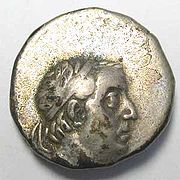
Ariobarzanes I Philoromaios of Cappadocia
Encyclopedia

Cappadocia
Cappadocia is a historical region in Central Anatolia, largely in Nevşehir Province.In the time of Herodotus, the Cappadocians were reported as occupying the whole region from Mount Taurus to the vicinity of the Euxine...
from 95 BC
95 BC
Year 95 BC was a year of the pre-Julian Roman calendar. At the time it was known as the Year of the Consulship of Crassus and Scaevola...
to ca. 63 BC
63 BC
Year 63 BC was a year of the pre-Julian Roman calendar. At the time it was known as the Year of the Consulship of Cicero and Hibrida...
-62 BC
62 BC
Year 62 BC was a year of the pre-Julian Roman calendar. At the time it was known as the Year of the Consulship of Silanus and Murena...
. Ariobarzanes I was a Cappadocian nobleman of obscure origins who was of Persian
Persian people
The Persian people are part of the Iranian peoples who speak the modern Persian language and closely akin Iranian dialects and languages. The origin of the ethnic Iranian/Persian peoples are traced to the Ancient Iranian peoples, who were part of the ancient Indo-Iranians and themselves part of...
descent.
Ariobarzanes I was originally put in place by the citizens vote of Cappadocia after the Roman Senate
Roman Senate
The Senate of the Roman Republic was a political institution in the ancient Roman Republic, however, it was not an elected body, but one whose members were appointed by the consuls, and later by the censors. After a magistrate served his term in office, it usually was followed with automatic...
rejected the claims of Ariarathes IX of Cappadocia
Ariarathes IX of Cappadocia
Ariarathes IX Eusebes Philopator , was made king of Cappadocia by his father King Mithridates VI of Pontus after the assassination of Ariarathes VII of Cappadocia. Since he was only eight years old, he was put under the regency of the Cappadocian Gordius...
and was supported by the Roman consul
Consul
Consul was the highest elected office of the Roman Republic and an appointive office under the Empire. The title was also used in other city states and also revived in modern states, notably in the First French Republic...
Lucius Cornelius Sulla
Lucius Cornelius Sulla
Lucius Cornelius Sulla Felix , known commonly as Sulla, was a Roman general and statesman. He had the rare distinction of holding the office of consul twice, as well as that of dictator...
. He was in control on and off of a kingdom that was considered a Roman protectorate and he was removed three separate times by King Tigranes the Great
Tigranes the Great
Tigranes the Great was emperor of Armenia under whom the country became, for a short time, the strongest state east of the Roman Republic. He was a member of the Artaxiad Royal House...
of Armenia before not only securing but actually increasing his lands under general Pompey
Pompey
Gnaeus Pompeius Magnus, also known as Pompey or Pompey the Great , was a military and political leader of the late Roman Republic...
in the Third Mithridatic War
Third Mithridatic War
The Third Mithridatic War was the last and longest of three Mithridatic Wars fought between Mithridates VI of Pontus and his allies and the Roman Republic...
. He eventually abdicated, making way for the rule of his son Ariobarzanes II of Cappadocia in ca. 63 BC
63 BC
Year 63 BC was a year of the pre-Julian Roman calendar. At the time it was known as the Year of the Consulship of Cicero and Hibrida...
-62 BC
62 BC
Year 62 BC was a year of the pre-Julian Roman calendar. At the time it was known as the Year of the Consulship of Silanus and Murena...
.
Ariobarzanes I married a Greek woman, whom he had as his queen a noblewoman called Athenais Philostorgos I
Athenais Philostorgos I
Athenais Philostorgos I, her surname can be spelt as Philostorgus was a Queen of Cappadocia.Athenais was a Greek noblewoman of obscure origins. She was the wife of the Cappadocian Persian nobleman and King Ariobarzanes I Philoromaios and her through marriage became a Queen of Cappadocia...
. Athenais bore Ariobarzanes I two children, a son, Ariobarzanes II who succeeded him and a daughter, Isias
Isias
Isias, surnamed Philostorgos or Philostorgus was a Princess of Cappadocia who lived in the 1st century BC. Through her marriage to King Antiochus I Theos of Commagene, she became the Queen of Commagene. Very little is known on her. She was half Persian and half Greek...
Philostorgos who married the King Antiochus I Theos of Commagene
Antiochus I Theos of Commagene
Antiochus I Theos Dikaios Epiphanes Philorhomaios Philhellenos Antiochus I Theos Dikaios Epiphanes Philorhomaios Philhellenos Antiochus I Theos Dikaios Epiphanes Philorhomaios Philhellenos (Greek: о Αντίοχος Θεός Δίκαιος Επιφανής Φιλορωμαίος Φιλέλλην, meaning Antiochos, a just, eminent god, friend...
.

